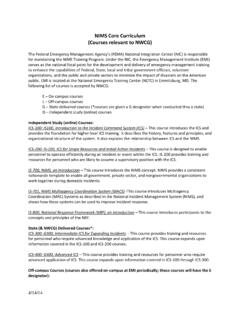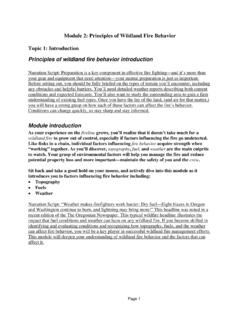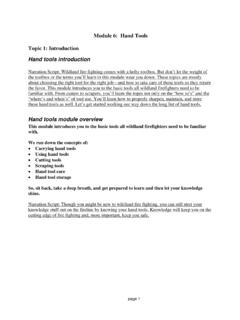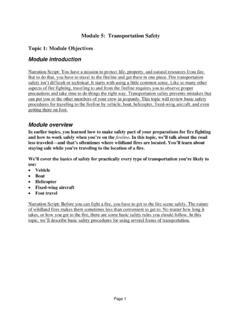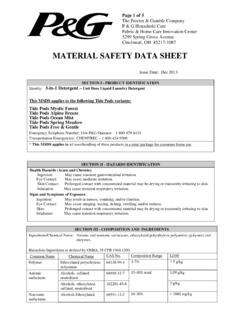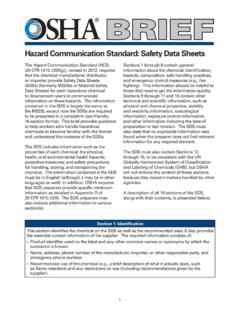Transcription of Module 9: Suppression, Communication, and Mop-up Topic 1 ...
1 Page 1 Module 9: Suppression, Communication, and Mop-up Topic 1: Introduction Module introduction Narration Script: Just about everything you do in the wildland fire service is designed to prepare you for the moment when you get the call to report for duty. You grab your gear, drive to the base, and get your briefing and assignment by Command. Last week, you went to a grass fire next to a road. Today the call is a wildland fire in a remote area. It s time to put your training to the real test.
2 As you drive to the scene, you gather more information and begin thinking about your response. What kind of conditions are you going to find? Will you have enough water? Which attack strategy might be most appropriate? In other words, how are you going to handle suppression, communication, and Mop-up ? It s time to do what you joined up for to fight and manage fires always remembering to provide for safety first. Fire suppression methods introduction Now it s time to find out what you ll actually be doing on the fireline. This Module introduces you to the many suppression techniques you have at your disposal to control and extinguish wildland fire. This is a broad (and deep!) Module where you ll find information on: Breaking the fire triangle Fire suppression techniques and safety Supporting heavy equipment operations and airdrops Communications Mop-up and patrol A wildland response can make for a long day, week, or even a month.
3 This Module will help you prepare for getting the job done. Narration Script: While there are an almost limitless number of ways to fight a wildland fire, you need to use those that maximize the safety of personnel and make the best use of resources. There is more to suppression, communications, and Mop-up than we can cover in this Module alone, but this info will give you a good grounding in the concepts and techniques required for a Firefighter Type 2. Page 2 Topic 2: Breaking the Fire Triangle Fire triangle introduction Maybe you never thought you d be using the laws of chemistry and physics when you got into the wildland fire fighting business, but that s exactly what you ll be doing when working to bring a fire under control.
4 In this Topic , you ll put on your science hat and refresh your memory on some key aspects of fire behavior including: Fire triangle components Breaking the fire triangle Narration Script: Believe it or not, fire management is as much science and smarts as it is muscle and brawn. However, unlike the controlled atmosphere of the classroom lab, you ll be out dealing with the real thing, so you better understand how it works! This Topic will cover the all-so-important basics of the fire triangle and aspects of the combustion process. If you have gone through the Introduction to Wildland Fire Behavior Course or S190 this should be a quick review for you. Fire triangle Fire is actually a by-product of a larger process called combustion .
5 In order for combustion to take place and produce fire, three ingredients are necessary: Oxygen Heat Fuel These three ingredients are the base for what firefighters call the fire triangle. Read the following to review your knowledge of the fire triangle. Oxygen Sources Wildland fuels have an abundant supply of oxygen available in the air. A concentration of approximately 16 percent oxygen is required for combustion , but normal air contains 21 percent more than enough for combustion to occur. In addition, some fuel materials contain sufficient oxygen within their makeup to support burning. Rapid oxidation occurs in two forms: Smoldering fires ones that burn without flame and are barely spreading Steady-state fires (unchecked rapid burning) steady-state fires are sometimes called free-burning fires Page 3 Heat Sources Heat sources sufficient to reach ignition temperature may come from.
6 Open flame Sun Lightning Hot surfaces Sparks and arcs Friction Chemical action Electric energy Compression of gases Fuel and Its Physical State Fuel may exist in any of the three states of matter solid, liquid, and gas. However, only gases burn. The initiation of combustion of a solid or a liquid fuel requires its conversion into a gaseous state by heating. During combustion , heat and chemical changes in the fuel cause fuel gases to evolve from the fuel. So, even though fuel and oxygen are present in the wildland, heat must be added to liberate the fuel gases and initiate the combustion process. Fuels in Gas Form Gas fuels can include: Natural gas Propane Butane Hydrogen Acetylene Carbon monoxide Fuels in Liquid Form Liquid fuels can include: Gasoline Kerosene Turpentine Alcohol Cod liver oil Paint Varnish Lacquer Olive oil Page 4 Fuels in Solid Form Solid fuels can include: Dust Coal Wood Paper Cloth Leather Plastic Sugar Grain Hay Cork Narration Script.
7 Let s start with a basic concept the fire triangle. There are lots of fuels trees, branches, brush in wildland areas, and fuel is obviously the foundation of the triangle. Fuel may exist in any of the three states of matter, but only gases burn. This means heat is required for fuel gases to form from wood and the other solid fuels you might find in the wildland. So, even though fuel and oxygen are present, heat must be added to free the fuel gases and begin the combustion process. Caption: The fire triangle represents the three components required for a fire. Page 5 Breaking the fire triangle You can control the combustion process (and extinguish the fire) by disrupting or removing one or more of the three required elements of the fire triangle.
8 In other words: Remove fuel Remove oxygen Remove the heat energy Read below about each method for more information. Remove Fuel Separating fuels or clearing a space of all surface fuels down to mineral soil (dirt containing little or no organic material) is a common way of controlling and extinguishing wildland fires. This is the basic idea behind the creation of any fireline. Remove Oxygen Wildland fires burn in the open air; therefore, attempting to restrict the oxygen supply to a fire (removing oxygen) is usually limited to smothering relatively small fires with dirt. Of course, make sure the dirt you use doesn t have a lot of flammable organic material in it, such as pine needles and dead leaves. Remove the Heat Energy Remove heat by applying water, dirt, retardant, or a combination of these.
9 Cooling the fire with water or Class A foam is one of the most common and effective fire extinguishing methods. You can also remove heat during night Mop-up by chunking the fuels, allowing them to burn down, and then spreading the hot materials to expose them to the cooler night air. Narration Script: You figure it out if fire requires fuel, oxygen, heat, how would you go about breaking the fire triangle and controlling the combustion process? Page 6 Knowledge Check 1 Matching select the match you choose from the pull down list.
10 Usually you try to avoid breaking things, but when it comes to controlling combustion in a wildland fire, breaking the fire triangle is the right thing to do. Match each way to break the fire triangle to the BEST method. You may use the steps to break the fire triangle more than once. Remove fuel Remove oxygen Remove heat Remove heat The correct matches are as follows: Remove fuel: Construct a fireline Remove oxygen: Smother with dirt Remove heat: Spray with water Remove heat: Spray with Class A foam Topic summary In this Topic , we gave you some basic fire concepts most likely a welcomed refresher from your Introduction to Wildland Fire Behavior (S-190) course.
